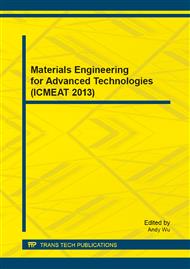[1]
C.R.I. Clayton, M.C. Matthews, and N.E. Simons: Site Investigation (Blackwell Science Ltd, 1995).
Google Scholar
[2]
M.H.Z. Abidin, F. Ahmad, D.C. Wijeyesekera, R. Saad, and M.F.T. Baharuddin, in: Soil Resistivity Measurements to Predict Moisture Content and Density in Loose and Dense Soil. Applied Mechanics and Materials, Vol. 353-356, pp.911-917 (2013).
DOI: 10.4028/www.scientific.net/amm.353-356.911
Google Scholar
[3]
A. Godio, C. Strobbia and, G. De. Bacco, in: Geophysical Characterisation of a Rockslide in an Alpine Region, Engineering Geology, Vol. 83, pp.273-286 (2006).
DOI: 10.1016/j.enggeo.2005.06.034
Google Scholar
[4]
H.J. Mauritsch, W. Seiberl, R. Arndt, A. Römer, K. Schneiderbauer, and G.P. Sendlhofer in: Geophysical Investigations of Large Landslides in the Carnic Region of Southern Austria, Engineering Geology, Vol. 56, pp.373-388 (2000).
DOI: 10.1016/s0013-7952(99)00120-9
Google Scholar
[5]
R. Khatri, V.K. Shrivastava and R. Chandak, in: Correlation between Vertical Electric Sounding and Conventional Methods of Geotechnical Site Investigation. International Journal of Advanced Engineering Sciences and Technologies, Vol. 4, pp.042-053 (2011).
Google Scholar
[6]
C. Liu, and J.B. Evett: Soils and Foundation (Pearson International, Singapore 2008).
Google Scholar
[7]
P. Cosenza, E. Marmet, F. Rejiba, Y. Jun Cui, A. Tabbagh and Y. Charlery. Correlations between geotechnical and electrical data: A case study at Garchy in France. Journal of Applied Geophysics, Vol. 60, pp.165-178 (2006).
DOI: 10.1016/j.jappgeo.2006.02.003
Google Scholar
[8]
R. Saad, N.M. Muztaza, and E.T. Mohamad, in: The 2D Electrical Resistivity Tomography (ERT) Study for Civil and Geotechnical Engineering Purposes. Electronic Journal of Geotechnical Engineering, Vol. 16, pp.1537-1545, (2011).
Google Scholar
[9]
Z. Jusoh, Application of 2-D Resistivity Imaging and Seismic Refraction Technique in Subsurface Investigation for Civil Engineering, M.S. thesis, Sch. Physics, Science Univ., Penang, Malaysia (2010).
Google Scholar
[10]
K.A.N. Adiat, M.N. Nawawi, and K. Abdullah, in: Assessing the Accuracy of GIS-based Elementary Multi Criteria Decision Analysis as a Spatial Prediction Tool – A case of Predicting Potential Zones of Sustainable Groundwater Resources. Journal of Hydrology, Vol. 440–441, pp.75-89 (2012).
DOI: 10.1016/j.jhydrol.2012.03.028
Google Scholar
[11]
R. Saad, M.N.M. Nawawi, and E.T. Mohamad, in: Groundwater Detection in Alluvium Using 2-D Electrical Resistivity Tomography (ERT). Electronic Journal of Geotechnical Engineering, Vol. 17, pp.369-376 (2012).
Google Scholar
[12]
U. Hamzah, A.R. Samsudin, and E.P. Malim, in: Groundwater investigation in Kuala Selangor using vertical electrical sounding (VES) surveys. Environmental Geology, Vol. 51, pp.1349-1359 (2007).
DOI: 10.1007/s00254-006-0433-8
Google Scholar
[13]
U. Hamzah, R. Yaacup, A.R. Samsudin, and M.S. Ayub, in: Electrical imaging of the Groundwater Aquifer at Banting, Selangor, Malaysia. Environmental Geology, Vol. 49, pp.1156-1162 (2006).
DOI: 10.1007/s00254-005-0160-6
Google Scholar
[14]
M.F.T. Baharuddin, S. Taib, R. Hashim, M.H.Z. Abidin, and M.F. Ishak, in: Time-lapse resistivity investigation of salinity changes at an ex-promontory land: a case study of Carey Island, Selangor, Malaysia. Environmental Monitoring and Assessment, Vol. 180, pp.345-369 (2011).
DOI: 10.1007/s10661-010-1792-x
Google Scholar
[15]
A.R. Samsudin, A. Haryono, U. Hamzah, and A.G. Rafek, in: Salinity mapping of coastal groundwater aquifers using hydrogeochemical and geophysical methods: a case study from north Kelantan, Malaysia. Environmental Geology, Vol. 55, pp.1737-1743 (2008).
DOI: 10.1007/s00254-007-1124-9
Google Scholar
[16]
A.R. Samsudin, B.E. A Rahim, W.Z.W. Yaacob, U. Hamzah, in: Mapping of contamination plumes at municipal solid waste disposal sites using geoelectric imaging technique: Case studies in Malaysia. Journal of Spatial Hydrology, Vol. 6 no, 2 (2006).
Google Scholar
[17]
R. Saad, I. Adli, and A.S. Mohamad, in: The Study of Iron Ore Prospect using 2-D Resistivity and Induced Polarization (IP) Method. Electronic Journal of Geotechnical Engineering, Vol. 17, pp.2981-2988 (2012).
Google Scholar
[18]
R. Saad, M.M. Saidin, N.M. Muztaza, N.A. Ismail, and N.E.H. Ismail, in: Subsurface Study Using 2-D Resistivity Imaging Method for Meteorite Impact at Bukit Bunuh, Perak. Electronic Journal of Geotechnical Engineering, Vol. 16, pp.1507-1513 (2011).
DOI: 10.1063/1.4914240
Google Scholar
[19]
M.H.Z. Abidin, D.C. Wijeyesekera, F. Ahmad, and R. Saad, in: Integral Analysis of Laboratory and Field Electrical Resistivity Value for Soil Moisture Content Prediction - Soft Soil Engineering International Conference, (2013).
DOI: 10.7763/ijet.2013.v5.652
Google Scholar
[20]
W.M. Telford, L.P. Geldart, and, R.E. Sheriff: Applied Geophysics (Cambridge University Press, 1990).
Google Scholar
[21]
M.H. Loke, I. Acworth, and T. Dahlin, in: A comparison of smooth and blocky inversion methods 2-D electrical imaging surveys. Explor Geophys, Vol. 34, No. 3, p.182–187 (2003).
DOI: 10.1071/eg03182
Google Scholar
[22]
Methods of Test for Soils for Civil Engineering Purposes, British standard 1377: (1990).
Google Scholar
[23]
Y. Jung, Y. Lee, and Ha, H. in: Application of Electrical Resistivity Imaging Techniques to Civil and Environmental Problems. Use of Geophysical Methods in Construction (2000).
DOI: 10.1061/40521(296)4
Google Scholar
[24]
K. Knödel, G. Lange, H.J. Voigt and K. Seidel, in: Direct Current Resistivity Methods Environmental Geology, Springer Berlin Heidelberg (2007).
Google Scholar


